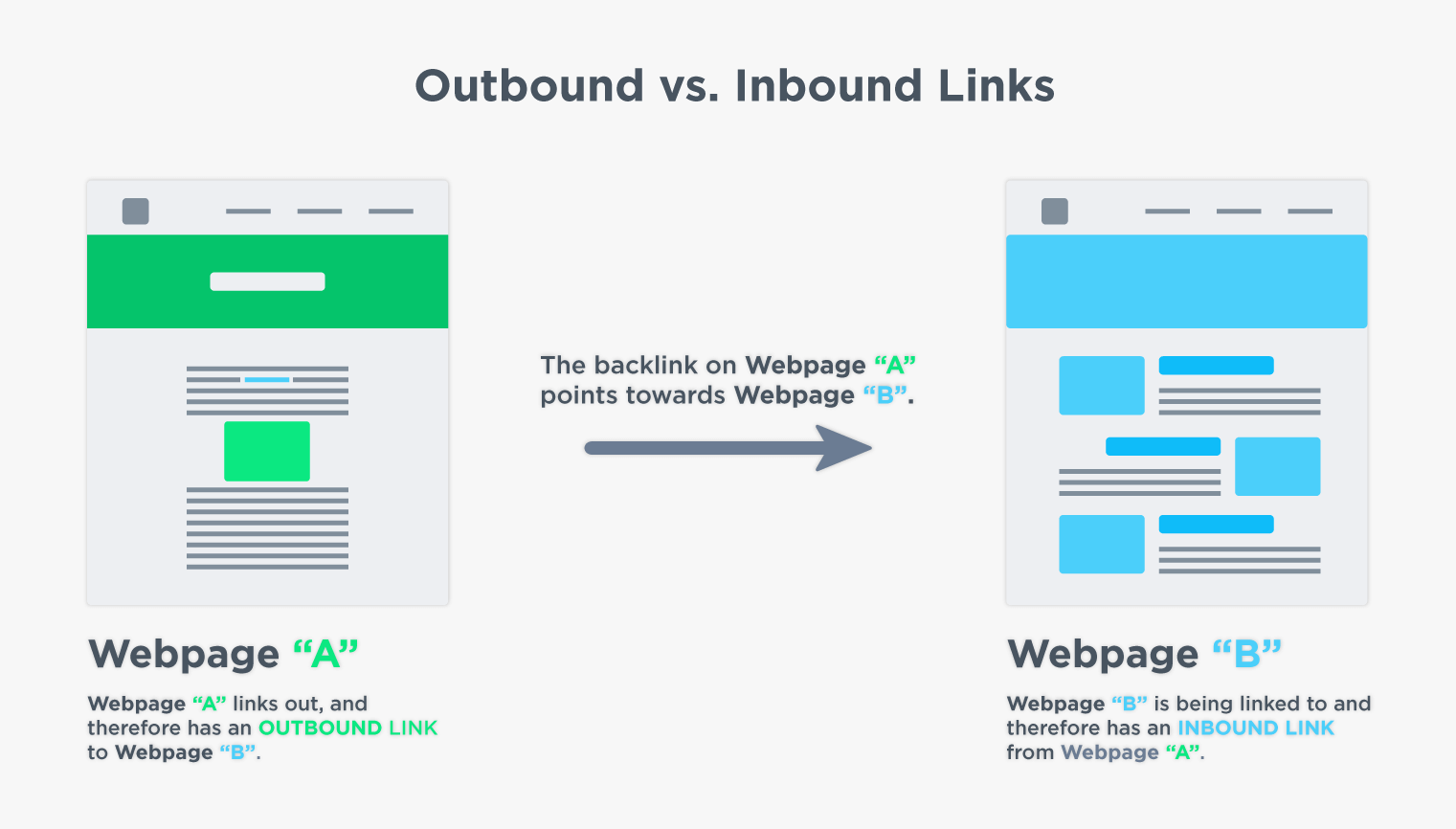Outbound Links are the least appreciated tactic in Content Marketing and the process of On-Page SEO Optimization. Anyone involved in SEO undoubtedly knows that a link from the external world to your site is an important signal contributing to the page’s ranking in search engine results.
But did you know that outbound links from your site also hold significant value?
If you’re looking for a short answer without reading the post, then the answer is yes. Outbound links definitely contribute to page ranking assuming they are used appropriately.
In fact, outbound links are a crucial aspect for SEO and higher ranking. Outbound links provide additional value to readers, Thus, they enhance the user experience on your site. And as we all know, a good user experience implies a significantly higher ranking.
What Are Outbound Links Exactly?
As a starting point, and for those new to the field, outbound links appear like this:
<a href=”http://www.example-domain.com/”>Link Anchor Text</a>And since many tend to confuse between types of links (even experienced website owners), let’s explain the different types of links once and for all:
- Internal Links – These are links that lead from one page on your site to another page on your site. Here’s an example of an internal link in Savvy Blog.
- External Links – These are links that lead from one site to another. However, note that there are two types of external links:
- One is Outbound Links, which we’ll discuss in this post – these are links leading from your site to another site.
- The second is Inbound Links or Backlinks – these links come from another site and lead to your site.
In other words, an Outbound Link is a link from your site to another site. An Outbound Link from your site is an Inbound Link for someone else.
There are some misconceptions about outbound links, here are a few of them:
- It’s best to avoid adding outbound links since they send visitors away from your site, and you have no control over the content on the other side of the link.
- The best way to retain visitors on your site when using outbound links is to ensure they open in a new tab in the browser.
- You should always mark outbound links with the nofollow attribute to retain the page’s ranking value where the link appears (Link Equity).
So not only are these myths, but implementing some of them could lead to negative or less than ideal outcomes in the end.
The Importance and Implications of Outbound Links
Outbound links are one of the ways search engines discover new content. They are important as they enhance site promotion, build trust, and establish relationships with other businesses. Let’s elaborate..
1. Outbound Links Contribute to User Experience and On-Page SEO
Outbound links bring balance and authenticity to the general “health” of the page in terms of SEO. Consider this, professional or academic articles always reference sources. “Outbound links help establish authority just like professional articles adding references at the end.”
So, it’s easy to imagine how outbound links can strengthen the topic of your article for Google and other search engines. In a hypothetical scenario where all parameters are the same between two pages on different sites, it makes sense that a page with an outbound link to relevant content would perform better than a page without those links.
But what will be the actual impact of these outbound links on the page’s ranking in search results?? From an SEO tactics standpoint, outbound links definitely don’t carry the same weight as inbound links, and you could even say they are significantly less impactful.
2. Outbound Links Help Build Trust in Your Content
Discerning readers nowadays seek signals that your content is authoritative and reliable, and outbound links serve as signals in this context.
You should include outbound links to content in order to support and strengthen the points you are trying to convey through additional evidence and opinions. This action will make the content on your site appear more reliable and trustworthy. Additionally, adding outbound links demonstrates to readers (and even to Google) that you have researched the topic and are not solely relying on your own opinions.
3. Outbound Links for Building Relationships
Building a relationship system with other websites can be beneficial in various ways. For example, you’ll find that adding calculated outbound links within your content can encourage various experts from those sites to participate and engage with your content when you ask them to.
Adding outbound links provides an opportunity to reach the owners of the site you’re linking to and prepare them for the fact that you will be referring to them from your post. In this case, it’s likely that there will be a higher chance they’ll assist you in promoting the post and sharing it in relevant places.
In summary of this section, few people in our day think that adding outbound links isn’t necessary; however, debates still exist about the best way to do it…
Adding Outbound Links – Best Practices
Many websites follow their own guidelines about when and how to add outbound links. Sometimes, these guidelines evolve due to observation and tracking of actions taken by other content writers.
Creating guidelines in the context that are clear to your content writers will enhance the effectiveness and usability of those outbound links they add to the content.
A. When should you add an outbound link?
Content marketers generally use outbound links to provide quick access to information about relevant content they aren’t writing on their own site.
“Think of outbound links as a way to provide additional background on topics you can’t fully cover in your post.”
Here are some guidelines for adding outbound links:
- Use them to support claims or facts you present.
- Reference the source of the information (origin).
- Utilize them to illustrate a specific point or idea.
- Give credit to the article that helped you form an opinion on the subject you’re writing about.
- Add them when quoting a specific idea someone else wrote about before you.
B. How can you determine if a specific page you’re considering linking to is a good choice?
Note that the choice of where to send your readers is as important as the decision to send the user to another source at all. When choosing where to link, consider the following points:
- How relevant is the page you’re linking to the point you’re trying to convey?
- Is the content on that page written accurately and without errors?
- Does the page also provide sources for the information it delivers?
- Is it the original source of the information?
- Does the organization that created the page have a good reputation?
- Is the author of the page you’re linking to a reliable source?
- When was the content on the page you’re linking to published, and is it updated?
- Avoid linking to pages with many ads that could frustrate readers.
- Avoid linking to pages with a poor user experience.
- Perhaps needless to say, but avoid linking to pages with paid content or requiring additional action from readers, such as registration (Gated Content).
For instance, I’m trying to link to content written in the last twelve months…
C. What about outbound links to competitor websites?
While only a few brave souls provide outbound links to their competitors, some do so without concern. Neil Patel argues, for example, that by prioritizing the interests of his site’s visitors over his own interests, meaning linking based on content quality rather than destination, it ultimately leads (according to him) to many users returning to his content.
He also claims in the video that he feels Google understands better where to rank his site due to those links, and that it even encourages his competitors to link back to him.
D. How many outbound links should I include?
Various tests and case studies show a correlation between the number of outbound links and search engine rankings if used correctly. However, there is no absolute truth about the ideal quantity of outbound links, and it’s certainly not black and white.
The average number of outbound links expected, by the way, is 19, but many pages ranked at the top have 100 or more outbound links. Yet, that doesn’t necessarily cause these pages to rank high.
Of course, in this context, the post length or the amount of content on the page where you’re adding outbound links needs to be considered.
So, understand that there’s no “magic number” for the ideal quantity of outbound links. As always, the idea is to treat your users and readers on your site as aspects related to SEO. If you see relevance in adding an outbound link and it contributes to the user experience, add it without overthinking, and certainly don’t stop yourself because you think you already have a significant number of outbound links in your content.
E. Should outbound links open in a new tab?
Most website owners believe that outbound links should open in a new tab in the browser, but there are user experience experts who think differently. Personally, I prefer opening links in a new tab, as you see in sub-blog, but even in this case, there’s no absolute truth.
This means that I haven’t encountered research that shows opening outbound links in a new tab significantly increases the likelihood of users returning to your site and spending more time there.
F. Should outbound links have the nofollow attribute?
A few years ago, SEO companies adopted the nofollow attribute to address the issue that outbound links weaken the “ranking power” or Link Equity of a page. But that was a long time ago and was resolved with Google’s update in 2009.
In the link before you, you’ll find a more comprehensive post about what NoFollow links are and when to use them.
Today, there are very specific situations where marking outbound links with the nofollow attribute is appropriate, but these situations are typically beyond the scope of typical outbound linking. Here’s a list of situations where the nofollow attribute might apply:
- Untrusted content
- Links to sponsored content
- Links to unverified guest posts
- Comment sections or forums
- Advertisements or paid inserts
- Links in widgets
- Links to low-quality, duplicated, or scraped content
- Links to user-generated content
This doesn’t mean, though, that you shouldn’t use the nofollow attribute in these situations. It’s a matter of understanding that in most cases, outbound links without nofollow tags have more value.
G. Should I mark all affiliate links as nofollow?
A hot topic, especially when considering this study by Reboot Online, which is about a Google Phantom update that targeted and hit affiliate sites. The conclusion Reboot reached was that not marking affiliate links as nofollow could be a contributing factor to the negative effects on Google.
Even so, this area still has a lot of ambiguity. Many marketers who are affiliates have not felt the need to mark their affiliate links with nofollow and have seen positive results. Some have tested and seen no difference.
How to Add Outbound Links – Conclusion
Remember, the aim of adding outbound links is to benefit the users and provide them with valuable information that enhances their understanding.
The key points to remember are:
- Add outbound links when they enhance the reader’s experience.
- Use relevant and accurate anchor text for your outbound links.
- Consider the context and relevance of the linked content.
- Don’t overdo it – prioritize quality over quantity.
- Monitor and update your outbound links to keep them current.
- Continuously evaluate your linking strategy based on your goals and user feedback.
With the above knowledge, you’re ready to start adding outbound links effectively to your content. Remember, outbound links are an essential aspect of modern web content, and using them wisely can significantly benefit your readers and enhance the credibility of your site.
- Navigation Links on Your Site’s Menu – This confuses users about where these links will take them and what to expect as the links in the navigation menu will lead them to other pages on your site.
- Landing Pages Intended for Actions Like Registration – But in these cases, there are exceptions where you are required to link to an external site for the purpose of gaining trust from visitors.
Either way, both of these fall outside the scope of Editorial Content, in which there’s almost always an advantage in linking to pages and relevant content on other sites.
By the way, you might want to differentiate and style differentiating outgoing links from internal links on your blog. Check the provided link to understand why.
Tracking Outbound Links in Google Analytics
Google Analytics 4 offers multiple methods for tracking outbound links, allowing you to understand user behavior as they navigate to external sites from your own.
Whether using automatic tracking through Enhanced Measurement or custom configurations with GA4 Explorations and Google Tag Manager, each approach provides unique insights to help optimize engagement and refine content strategy.
1. Enable Enhanced Measurement for Automatic Outbound Link Tracking
GA4 allows automatic tracking of outbound link clicks with the Enhanced Measurement feature. To enable this:
- Go to Admin > Data Streams and select your web stream.
- Ensure that Enhanced Measurement is enabled.
- Toggle on Outbound clicks to capture clicks leading users to external domains.
a. View Outbound Link Data in Standard Reports
Once tracking is enabled, you can view basic outbound link data:
- Navigate to Reports > Engagement > Events.
- Look for the click event, which represents outbound clicks if Enhanced Measurement is active. This report provides basic click counts, but not specific URLs.
b. Create a Detailed Custom Report Using GA4 Explorations
To capture specific URLs of clicked outbound links, create a custom report in GA4’s Explorations:
- In GA4, go to Explore and select a Blank or Free Form template.
- Add dimensions: Event Name (for tracking clicks) and Link URL (for detailed URL capture).
- Add metrics: Event Count and Total Users to measure the frequency and unique user clicks.
- Apply a filter: Set Event Name to “click” to focus on outbound link interactions.
Using custom reports in GA4 provides a powerful way to analyze outbound link performance in detail.
c. Use Custom Dimensions for Link Domains
To get additional insights, create a custom dimension in GA4 for Link URL or Link Domain under Admin > Custom Definitions. This customization allows analysis of outbound traffic by specific domains within standard reports, giving more context to outbound link data.
2. Optional: Enhanced Tracking with Google Tag Manager (GTM)
For greater control over outbound link tracking, consider using Google Tag Manager (GTM):
- Create a GA4 Event Tag in GTM named outbound_click.
- Set a trigger for Click – Just Links, configured to fire only on external links.
- Publish the tag and verify your setup using GTM’s Preview Mode.
GTM provides flexibility for tracking specific outbound links or setting up advanced conditions.
With these methods, you can comprehensively track and analyze outbound links in GA4, tailoring insights to optimize user engagement and site strategy.
Summary
Outbound links are an important way websites participate in and contribute to the internet as a whole. They add value to the user, help promote your site, and open channels of communication and dialogue with other businesses.
As you can see, there are many aspects to consider when it comes to proper use of outbound links. Some depend on the context, like evaluating the source you’re linking to, and some are clear by themselves, like using the nofollow attribute when linking to sponsored content.
So, in conclusion, in this post, we’ve covered most of the common questions related to the best practices and appropriate situations for embedding outbound links on your site. Did you discover anything new in response to this post? Do you have any insights regarding what’s written in the post? We’d be glad if you share your thoughts in the comments… Good luck!
Further Reading & Inspiration:



